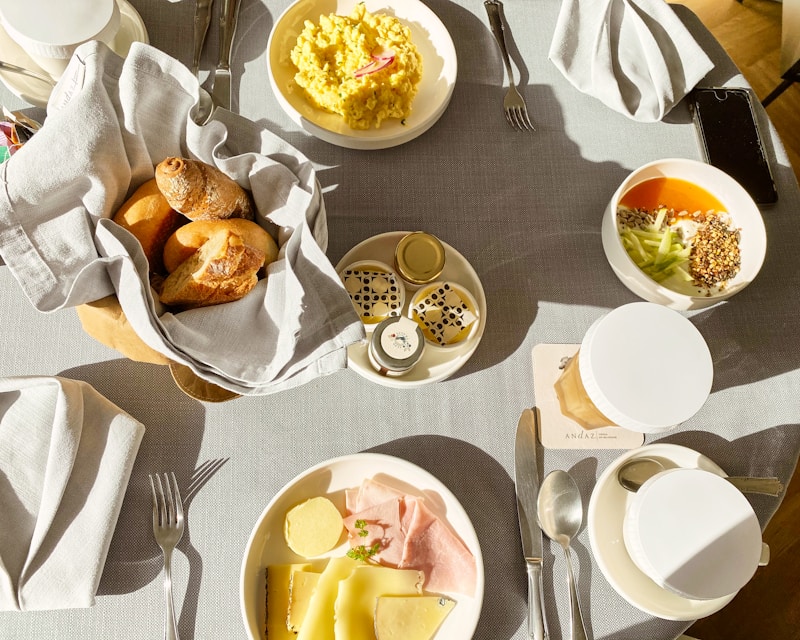9 Questions
What is the most common meat consumed in Germany?
What is the most common herb or spice used in German cuisine?
Which region of Germany is known for its green sauce and cider?
What is the most common side dish in German cuisine?
What is the most common type of beer in Germany?
What is the most common type of white wine in Germany?
Which German state is known for its Maultaschen, Spätzle, and Black Forest cake?
What is the most common breakfast item in Germany?
Which German region is known for its Pfälzer Saumagen, a pork stomach stuffed with sausage meat, bacon, potatoes, and spices?
Summary
Culinary Traditions of Germany:
- Germany has many regional cuisines reflecting the country's federal history.
- Germany shares many culinary traditions with neighbouring countries such as Poland, the Czech Republic, and Denmark.
- The Michelin Guide awarded 11 German restaurants three-star rankings, making Germany fourth in the world for Michelin three-star restaurants.
- The average annual meat consumption per person in Germany is 59.7 kg (132 lb), with pork, poultry, and beef being the most common varieties.
- Over 1,500 different types of sausage (Wurst) are made in Germany, with Bratwurst, Wiener, and Blutwurst being among the most popular.
- Salmon used to be common in the rivers Rhine, Elbe, and Oder but slowly started to return only with a growing consciousness for environmental questions and resulting measures.
- Asparagus is a popular seasonal side or main dish in Germany, with a yearly per-capita consumption of 1.5 kg (3.3 lb).
- Breakfast (Frühstück) commonly consists of bread, toast, cold cuts, cheeses, jam, honey, and eggs, with coffee, tea, milk, cocoa, or fruit juices.
- Lunch (Mittagessen) is traditionally the main meal of the day, eaten around noon, while dinner (Abendessen or Abendbrot) is a smaller meal, often consisting only of a variety of breads, meat or sausages, cheese, and some kind of vegetables.
- Noodles, potatoes, and dumplings are common side dishes in German cuisine.
- Mustard, horseradish, and fresh dill are among the most popular herbs and spices used in German cuisine.
- German desserts include a wide variety of cakes, tarts, pastries, doughnuts, pancakes, puddings, and ice creams, with fresh fruit being a common ingredient.German Cuisine: Bread, Beverages, and Regional Specialties
Bread is a significant part of German cuisine, with the largest bread diversity in the world. Around 3000 types of bread and 1,200 different types of pastries and rolls are produced in about 13,000 bakeries.
Bread is usually served for breakfast and in the evening as sandwiches or as a side dish for the main meal, especially with Eintopf or soup. Germans use almost all available types of grain for their bread, including wheat, rye, barley, spelt, oats, millet, corn, and rice.
Bread rolls, known in Germany as Brötchen, are common in German cuisine. A typical serving is a roll cut in half and spread with butter or margarine. Cheese, honey, jam, cold cuts such as ham, fish, or preserves are then placed between the two halves, or on each half separately, known as a belegtes Brötchen.
Beer is very common throughout all parts of Germany, with many local and regional breweries producing a wide variety of beers. The pale lager pilsner is predominant in most parts of the country today, whereas wheat beer and other types of lager are common, especially in Bavaria.
Wine is also popular throughout the country. German wine comes predominantly from the areas along the upper and middle Rhine and its tributaries. Riesling and Silvaner are among the best-known varieties of white wine, while Spätburgunder and Dornfelder are important German red wines.
Bavarian cuisine is closely connected to Czech cuisine and Austrian cuisine, mainly through the Wittelsbach and Habsburg families. A Bavarian speciality is the Brotzeit, a savoury snack, which would originally be eaten between breakfast and lunch.
Baden-Württemberg features the highest density of star-rated restaurants in Germany. Swabian cuisine tends to be heavier than Badish cuisine. Famous dishes of Baden-Württemberg are Maultaschen, Spätzle, and Black Forest cake.
Franconia, a major region consisting roughly of the northern half of Bavaria, has its own distinct cuisine, so distinct in fact that there is said to be a "White Sausage Equator" that separates Franconia from the rest of Bavaria.
Hamburg's traditional cuisine is very diversified and sapid as the supply of ingredients was safe. Until the 20th century, it was predominantly characterized by the extensive choice of different kinds of fish from the river Elbe and the quick access to both the North Sea and the Baltic Sea.
Typical for Hessen are Frankfurter Rippchen, a spiked pork cutlet, which is often served with sauerkraut and mashed potatoes. Also from Hessen comes the Frankfurt green sauce ("Grüne Sauce").
German supermarkets sell Christmas bakery products during the Advent and Christmas season, including sweet and spicy foods like Weihnachts-/Christstollen, Lebkuchen, Spekulatius, Marzipan, Weihnachtsplätzchen, Vanillekipferl, Zimtsterne, and Dominosteine.Regional Cuisines of Germany
- Frankfurt is famous for its green sauce and cider. The cider taverns in the Cider Quarter offer "Handkäs mit Musik" as a snack, a sour milk cheese served in a marinade of onions, vinegar and spices.
- Palatinate/Pfalz is known for its regional dishes such as Pfälzer Saumagen, a pork stomach stuffed with sausage meat, bacon, potatoes, and spices. Another traditional main dish is the salty-crust Dampfnudel, either served with sweet side dishes like wine sauce, custard, boiled fruits, or with salty side dishes like potato soup, vegetable soups, goulash, or pork.
- Thuringia is the second-largest herb-growing region in Germany and is one of the best game-hunting regions in Germany. The most popular foods from Thuringia are Thuringian sausages and Thuringian dumplings. The state is also famous for its sausages, including steamed, scaled, and cured varieties.
- Saxony is known for its hearty cuisine and variety of sauces. Freshwater fish, particularly carp and trout are widely used, as well as potatoes with Quark, potato soup, and potato with bread and linseed oil.
- Germany has adopted several international cuisines, including Italian dishes like spaghetti and pizza, which have become staples of the German diet. Turkish immigrants have introduced döner kebab, while Arab, Chinese, Balkan, Japanese, and Greek restaurants and bars are also widespread in Germany. Indian, Vietnamese, Thai, and other Asian cuisines are rapidly gaining popularity since the early 2000s.
- Germany is the third largest agricultural producer in the European Union and the third largest agricultural exporter in the world. In 2013, German food exports were worth around EUR 66 billion.
Description
How well do you know German cuisine? Take this quiz to test your knowledge on the diverse culinary traditions of Germany, including regional specialties, popular dishes, and iconic beverages. From the largest bread diversity in the world to over 1,500 types of sausage, discover fascinating facts about German food culture. Impress your friends with your newfound knowledge of German cuisine and its international influences. Prost!





